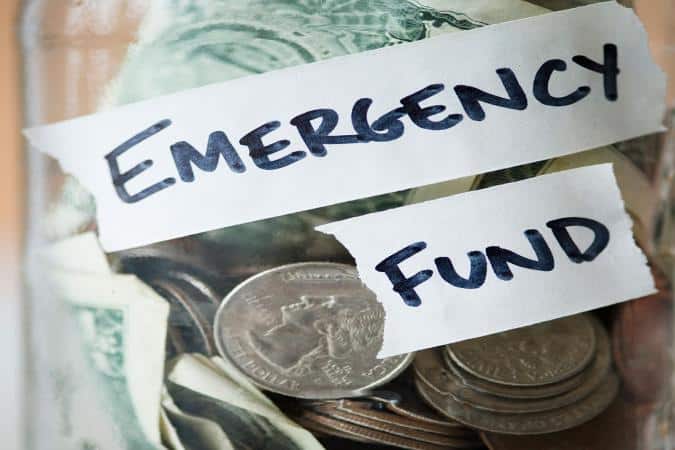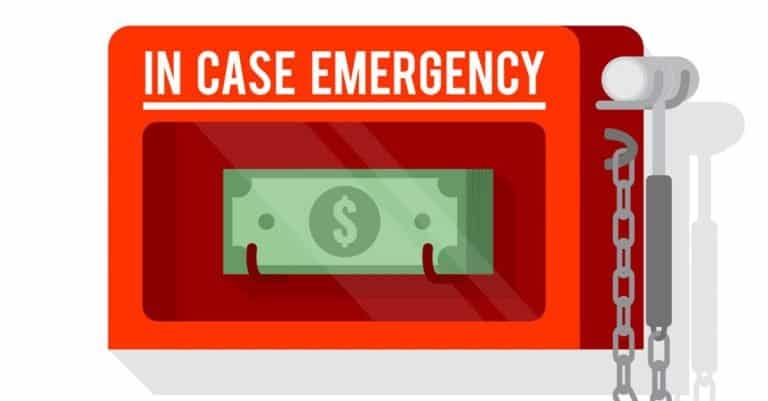If you’ve been reading about personal finance, you’ve probably heard of an emergency fund before. That’s because emergency funds are one of the most important aspects of personal finance.
Every Individual should have an emergency fund.
It need not be you are working, you can still be a college student, university graduate or whatever, you should still be having an emergency fund.
You know why?
You’ll probably never know when the rainy days occur. Emergency funds should be your first choice to liquidate and get out of the situation gracefully, and no not your investments. Do not touch them, let them continue to grow 🙂
Once your emergency funds are utilized completely and you still need funds to run the show, then you can probably think of touching other investments or savings. Again, emergency funds are only for “emergency” purposes, and not for your routine iPhone/iPad purchases!
With that said, there are a couple of questions and confusion surrounding emergency funds. That’s one of the sole reasons, I wanted to create this ultimate guide to answer all those common questions and clear up any confusion you may have about emergency funds. Now, then let’s get started and start saving into an emergency fund soon!
What Is An Emergency Fund?
An emergency fund is an account for funds set aside in case of the event of a personal financial dilemma, such as the loss of a job, a debilitating illness or a major repair to your home.
Here are the two main benefits:
1. Peace of mind – Imagine having $2,000 stashed away somewhere in case of emergency. Wouldn’t you feel a lot more at ease knowing that if life takes a poop on you, you’re at least wearing a diaper on your head?
2. Money saved – Having an emergency fund can save you a lot of money. How? Because you won’t have to borrow money and pay interest to deal with emergencies. You’ll already have the money on hand.

What Are Emergency Funds For?
Like I said above, emergency funds are strictly for emergencies only.
But, what is an emergency?
An emergency is something urgent & unexpected that requires money to be solved.
This includes things like:
-
Job loss
-
Medical or dental emergencies
-
Car troubles
-
Unplanned travel expenses
-
Unexpected Home repairs
Emergency funds are not meant for:
-
Buying gifts
-
Going on vacation
-
Eating out
What’s not easy is committing to using your emergency fund for emergencies only. It’s going to be very tempting to use that large sum of cash for other things.
However, if you take out a bit of money here and there for things that aren’t emergencies, you’re creating a bad habit that could cause problems in the future if an emergency ever were to strike.
That’s why you need a better place to keep your emergency fund so it’s not as easy to spend.
Top 3 Benefits Of Having An Emergency Fund
1. It helps keep your stress level down
It’s no surprise that when life presents an emergency, it threatens your financial well-being and causes stress. If you’re living without a safety net, you’re living on the “financial” edge—hoping to get by without running into a crisis.
Being prepared with an emergency fund gives you confidence that you can tackle any of life’s unexpected events without adding money worries to your list.
2. It keeps you from spending on a whim
You’ve heard the saying “out of sight, out of mind.” That’s the best way to store your emergency money. If the cash is only as far away as your closest debit card, you may be tempted to use it for something frivolous like a designer cocktail dress or big-screen TV—not exactly an emergency.
Keeping the money out of your immediate reach means you can’t spend it on a whim, no matter how much you’d like to.
And by putting it in a separate account, you’ll know exactly how much you have—and how much you may still need to save.
3. It keeps you from making bad financial decisions
There may be other ways you can quickly access cash, like borrowing, but at what cost? Interest, fees, and penalties are just some of the drawbacks.

Where To Keep An Emergency Fund?
One of the most common questions asked is where to put an emergency fund.
The answer is quite simple:
The key to storing an emergency fund is to make sure the money is easy to access, but not too easy.
For example, I would not recommend keeping your emergency fund in your main bank account. You might get it mixed up with your regular savings, or you might accidentally spend it.
Instead, I recommend keeping your emergency fund in a separate high-interest online savings account.
Wealthsimple offers good online savings accounts with a 1.95% interest rate.
Should I Pay Off My Debt Before Building an Emergency Fund?
If you’ve got credit card debt with a 14 – 20% interest rate, you’ve already got an emergency on your hands. That means you should focus all your effort on paying off that credit card debt as quickly as possible.
Once it’s gone then you can start building your emergency fund.
If you’re dealing with debt other than credit card debt, you should build a $500-$1,000 emergency fund while you pay off your debt. This will cover any basic emergencies and help you avoid going into credit card debt.
Something is Better than Nothing
Don’t think you can save enough? Don’t panic. You can build up to it by stashing away smaller amounts on a regular basis, like every week or every paycheck. If you keep it up, over time you’ll eventually meet your goal.
The important thing is that you’ve started saving something.
For instance, let’s say you set aside $25 a week in an emergency fund. At the end of 2 years, you could have $2,600 saved. Increase that amount to $50 a week and your savings could grow to $5,200. Make it $75 a week and you’ll see an even larger amount saved—$7,800.

How Much Money Should You Have In Your Emergency Fund?
The amount you’ll want to save in your emergency fund will vary based on your circumstances, but these are the steps I would take if I were just starting to build my emergency fund:
-
Build a $500 emergency fund. You can do this quickly by selling things around the house or doing other things to make extra money.
-
Build it up to $1,000. Now you’ve just got to do what you did in step 1, again.
-
Cover 3-months of living expenses. To figure this number out, just multiply your monthly expenses by three. If you don’t know your avg. monthly expenses, you should learn how to start a budget.
The reason I recommend these three steps is because each time you complete one step, you’ll get a little kick of motivation that will help you accomplish the next step. It’s all about starting small and working your way up.
Once you complete step 3, it’s up to you whether you want to continue to build your emergency fund or leave it as is. Some people will need to cover 6-months or 12-months of living expenses, while others may be comfortable with just 3-months coverage.
Your emergency fund size will depend on your circumstances
For example, a freelancer whose income is irregular may want to save more in their emergency fund since they might not know when the next pay-check is coming.
Top 7 Ways To Build An Emergency Fund
There are a lot of different ways to build your emergency fund, but in the end, it all comes down to money. You either need to make more, save more, or both.
Here are some good ways to save money for an emergency fund:
-
Save $10 each week. At the end of the year, you’ll have $520 in your emergency fund.
-
Take a percentage off your pay-check. Start with 5% and raise it up as you get more comfortable. If you’ll do this with every pay-check you should be able to build your emergency fund quite quickly.
-
Save your tax refund. If you get a tax refund, put it straight into your emergency fund for a quick boost. You only have one chance a year for this one so don’t blow it.
-
Use an Automatic money-saving app. This shouldn’t be your only source of savings, but it’s a good savings side-kick. If you’re from Canada you can use Mylo to invest your spare change.
-
Cut down expenses. Assuming you have a budget (learn how to create one), you should look through your expenses and see if you can make any cuts.
-
Save the change (spare money) – Mylo does this for you, but you can also save any spare change you get over the year (think 5-dollar bills, etc.) and put it straight into your emergency fund.
-
Make extra money (side income) – This is one of the best ways to build your emergency fund quickly. Check out these 20 ways to make extra money on the side.
Final Words
Hopefully, you now have a better understanding of emergency funds and why they are such an important part of your personal finances.
Remember that your emergency fund is going to be something you’ll have to constantly work on. If you have an emergency and take money out of your emergency fund, you’ll have to work on rebuilding it again as soon as possible.
If you enjoyed the content here, do share it on social media and help spread the word. Also, please let me know your questions, thoughts and comments below.
